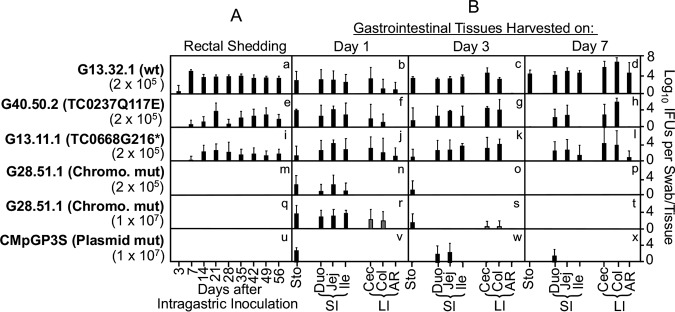FIG 1.
Comparing C. muridarum organisms with or without mutations in chromosomal genes tc0668 and/or tc0237 or plasmid gene pgp3 for colonizing the gastrointestinal tract following oral/intragastric inoculation. (A) The wild-type (wt) clone G13.32.1 or C. muridarum with a substitution mutation in chromosomal gene tc0237 (G40.50.2 [TC0237/Q117E]), a premature stop codon in chromosomal gene tc0668 (G13.11.1 [TC0668/G216*]), a tc0668 premature stop codon plus a tc0237 substitution mutation (G28.51.1 [TC0668/G216* TC0237/Q117E]), designated a chromosomal mutant, or a premature stop codon in plasmid gene pgp3 (CMpGP3S, designated a plasmid mutant) was orally/intragastrically inoculated into female C57BL/6J mice at the indicated doses (IFUs) (n = 5 mice per group). On days 3 and 7 and weekly thereafter, after inoculation as shown along the x axis, rectal swabs were taken for monitoring live chlamydial organism shedding. Note that both the chromosomal mutant G28.51.1 and the plasmid mutant CMpGP3S failed to colonize the gut. P < 0.05 (for comparison of the area under curve between panels a and m, q, or u; Wilcoxon test). (B) Parallel groups of mice (n = 5) were sacrificed on the indicated days after intragastric inoculation for monitoring live chlamydial organisms in different segments of the gastrointestinal tract including the stomach (Sto), small intestine (SI) tissues of the duodenum (Duo), jejunum (Jej), and ileum (Ile) and large intestine (LI) tissues of the cecum (Cec), colon (Col), and anorectum (AR) as indicated. Note that the chromosomal mutant G28.51.1 reached the colon following intragastric inoculation (panels r and s) while the plasmid gene mutant CMpGP3S failed to do so (panels v to x). P < 0.05 (for a comparison of the numbers of IFUs recovered from cecum or colon in G28.51.1- and CMpGP3S-infected mice, as highlighted in panels r and v; Wilcoxon test).

